Union Station (Toronto)
| Union Station Via Rail, Amtrak, Ontario Northland (Inter-city) GO Transit (Commuter) |
|||||||||||||||||||||||||||||||||||||||||||||||||||||||||||||||||||||||||||||||||||||||
|---|---|---|---|---|---|---|---|---|---|---|---|---|---|---|---|---|---|---|---|---|---|---|---|---|---|---|---|---|---|---|---|---|---|---|---|---|---|---|---|---|---|---|---|---|---|---|---|---|---|---|---|---|---|---|---|---|---|---|---|---|---|---|---|---|---|---|---|---|---|---|---|---|---|---|---|---|---|---|---|---|---|---|---|---|---|---|---|
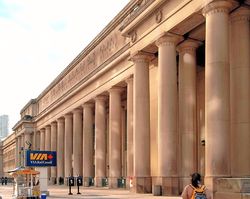 The main entrance to Union Station. |
|||||||||||||||||||||||||||||||||||||||||||||||||||||||||||||||||||||||||||||||||||||||
| Station statistics | |||||||||||||||||||||||||||||||||||||||||||||||||||||||||||||||||||||||||||||||||||||||
| Address | 65 Front Street West Toronto, ON |
||||||||||||||||||||||||||||||||||||||||||||||||||||||||||||||||||||||||||||||||||||||
| Lines | See services below | ||||||||||||||||||||||||||||||||||||||||||||||||||||||||||||||||||||||||||||||||||||||
| Connections | Union Subway Station TTC buses GO Transit (Union Station Bus Terminal) |
||||||||||||||||||||||||||||||||||||||||||||||||||||||||||||||||||||||||||||||||||||||
| Structure | At-grade | ||||||||||||||||||||||||||||||||||||||||||||||||||||||||||||||||||||||||||||||||||||||
| Levels | 1 | ||||||||||||||||||||||||||||||||||||||||||||||||||||||||||||||||||||||||||||||||||||||
| Platforms | Elevated | ||||||||||||||||||||||||||||||||||||||||||||||||||||||||||||||||||||||||||||||||||||||
| Tracks | 14 (12 covered) | ||||||||||||||||||||||||||||||||||||||||||||||||||||||||||||||||||||||||||||||||||||||
| Parking | No | ||||||||||||||||||||||||||||||||||||||||||||||||||||||||||||||||||||||||||||||||||||||
| Bicycle facilities | Yes | ||||||||||||||||||||||||||||||||||||||||||||||||||||||||||||||||||||||||||||||||||||||
| Baggage check | Yes | ||||||||||||||||||||||||||||||||||||||||||||||||||||||||||||||||||||||||||||||||||||||
| Other information | |||||||||||||||||||||||||||||||||||||||||||||||||||||||||||||||||||||||||||||||||||||||
| Opened | 1927 | ||||||||||||||||||||||||||||||||||||||||||||||||||||||||||||||||||||||||||||||||||||||
| Rebuilt | 1970s, 2009-2014 (planned) | ||||||||||||||||||||||||||||||||||||||||||||||||||||||||||||||||||||||||||||||||||||||
| Accessible | |||||||||||||||||||||||||||||||||||||||||||||||||||||||||||||||||||||||||||||||||||||||
| Code | Amtrak code:TWO GO Transit: USTN |
||||||||||||||||||||||||||||||||||||||||||||||||||||||||||||||||||||||||||||||||||||||
| Owned by | City of Toronto (station building) GO Transit (trainshed and tracks) Toronto Terminals Railway (operator) |
||||||||||||||||||||||||||||||||||||||||||||||||||||||||||||||||||||||||||||||||||||||
| Fare zone | 02 | ||||||||||||||||||||||||||||||||||||||||||||||||||||||||||||||||||||||||||||||||||||||
| Presto card | Yes | ||||||||||||||||||||||||||||||||||||||||||||||||||||||||||||||||||||||||||||||||||||||
| Traffic | |||||||||||||||||||||||||||||||||||||||||||||||||||||||||||||||||||||||||||||||||||||||
| Passengers (2004) | 2.34 million |
||||||||||||||||||||||||||||||||||||||||||||||||||||||||||||||||||||||||||||||||||||||
| Passengers (2004) | 41 million |
||||||||||||||||||||||||||||||||||||||||||||||||||||||||||||||||||||||||||||||||||||||
| Passengers (2004) | 20 million |
||||||||||||||||||||||||||||||||||||||||||||||||||||||||||||||||||||||||||||||||||||||
| Services | |||||||||||||||||||||||||||||||||||||||||||||||||||||||||||||||||||||||||||||||||||||||
|
|||||||||||||||||||||||||||||||||||||||||||||||||||||||||||||||||||||||||||||||||||||||
Union Station is the major inter-city rail station and a major commuter rail hub in Toronto, located on Front Street West and occupying the south side of the block bounded by Bay Street and York Street in the central business district. The station building is owned by the City of Toronto, while the trainshed and trackage is owned by the commuter rail operator GO Transit. Serving 200,000 passengers a day,[1] it is the busiest passenger transportation facility in Canada.[1]
Inter-city trains at Union Station are operated by Via Rail, Amtrak and Ontario Northland, while commuter rail services are operated by GO Transit. The station is also connected to the Toronto Transit Commission (TTC) subway and streetcar system via an adjoining TTC station. GO Transit's Union Station Bus Terminal, located across Bay Street from the station building, is connected via the trainshed.
Union Station is the central terminal for GO Transit, handling approximately 41 million commuter rail passengers in 2004.[2] Union Station is also located at the centre of Canada's busiest inter-city rail service area, termed "The Corridor" by Via, that stretches from Quebec City in the east to Windsor in the west. As such, Union Station is Via's most-used facility; the station saw 2.34 million Via Rail boardings in 2004, more than half of all Via passengers carried systemwide that year.[2]
Union Station's station code is TWO.
Contents |
The structure

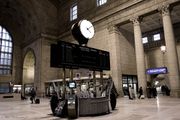
Toronto's third Union Station was constructed between 1914-1920 by the TTR and is the largest and most opulent railway station erected in Canada, particularly in light of the failure of the GTR to construct its planned replacement to Montreal's Bonaventure Station. The building was designed by the Montreal architecture firm of Ross and Macdonald, with assistance from the CPR's architect Hugh Johnes, as well as Toronto architect John M. Lyle. Its design was cited in 1975 by the Historic Sites and Monuments Board of Canada as being of "national architectural significance as one of the finest examples of Beaux Arts railway station design in Canada."[3]
The building comprises three distinct sections facing Front Street West and occupying the entire south side of the block between Bay Street in the east and York Street in the west. The building measures 752 feet (229 m) long and the Front Street facade features 22 stone columns, each 40 feet (12 m) high and weighing 75 tons and are turned from Bedford limestone. The exterior of the building is constructed with Indiana and Queenston limestone and the building measures 87 feet (27 m) high while the central portion is 112 feet (34 m) high.
The building has a colonnaded porch facing Front Street which enters into the expansive Ticket Lobby, which has come to be informally known as the "Great Hall". Via Rail's ticket counters and baggage counters are located in this space and passengers may sit in adjacent waiting rooms or seek train information; Via Rail ticket agents handle all ticketing sales and baggage services for Amtrak and Ontario Northland passengers. This "Great Hall" is 250 feet (76 m) long and 88 feet (27 m) high at the apex of its vaulted ceiling which is constructed of Guastavino tiles and is lit with natural light from clerestory windows refracted throughout the lobby. Each end of the "Great Hall" features 4-storey tall arched windows and the walls of this room are faced with Zumbro stone from Missouri while the floor is constructed of Tennessee marble laid in a herringbone pattern. Below the cornice surrounding the "Great Hall" is carved the names of many destinations across Canada that one could travel to via the GTR or CPR systems at the time of the station's construction.
Stairways at either end of the "Great Hall" lead to the Arrivals Concourse which is used by Via Rail, Amtrak and Ontario Northland for inter-city train passengers. There is access from this level to the GO Concourse which is used by GO Transit commuter train passengers, as well as access to the TTC subway and streetcar station and the PATH pedestrian tunnel network which connects to the Royal York Hotel and many of the major office buildings in the central business district. Union Station also features office space used by the TTR, GO Transit and CN and CP.
Union Station has appeared in various films and television series, often representing settings in other cities[4].
History
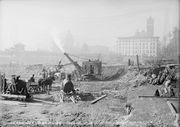
The current Union Station was officially opened to the public on August 6, 1927 in a lavish ribbon cutting ceremony by Prince Edward, Prince of Wales (using a pair of gold scissors). In attendance were Prince George, Lieutenant Governor of Ontario William Donald Ross and his wife, Prime Minister of Canada William Lyon Mackenzie King, Prime Minister of the United Kingdom Stanley Baldwin and Mrs. Baldwin, Premier of Ontario George Howard Ferguson, and numerous other members of the Ontario and Canadian governments.[5]
Predecessor stations
The history of the current Union Station can be traced to 1858 when Toronto's first Union Station was opened by the Grand Trunk Railway just west of the present Union Station. This wooden structure was shared with the Northern Railway and the Great Western Railway. The GTR replaced the first Union Station with a second Union Station on the same site, opening in 1873. As both the Northern Railway and Great Western Railway had been acquired by the GTR, this was not a true Union station, however the Canadian Pacific Railway began using the facility in 1884 and it was completely rebuilt, opening in 1896.
The Great Toronto Fire of 1904 demolished the block south of Front Street West, immediately east of the second Union Station (bounded by Bay and York streets), but did not damage the station itself. The GTR acquired this land east of the second Union Station for a new passenger terminal and in 1905 both the GTR and the CPR decided to proceed with the design and construction of a third union station.
The decision to undertake the third union station was made against a backdrop of significant change in the Canadian railway industry. At the same time, the federal government was encouraging the GTR to proceed with constructing a second transcontinental railway (what would later become the Grand Trunk Pacific Railway and the National Transcontinental Railway) and the Canadian Northern Railway was undertaking an aggressive expansion across the Prairies and into southern Ontario.
The columns, particularly those at the grand entrance (inside and outside), are carved incompletely. The top portion of the columns are carved in the Greek Doric order, but only for just little over a foot. Below that, the columns are left in simple smooth cylindrical shape, ending on a very incongruous octagonal base stones. It is hard to ascertain what the original plan had intended for the finished columns. If in a Doric style (as the top portions are clearly carved in that manner), then the column must rest directly on the platform below without any base stones. But, there are those rough octagonal base stones there, which, imply an Ionic order or Corinthian order base stone or an otherwise Doric columns. This incongruity may have been a reason for not finished the carvings of the columns. At the original New York Penn Station, the columns were given a Roman finish--Corinthian capitals, smooth cylindrical trunk. Not so at Toronto. The styles are mixed and left unfinished.
Toronto Terminals Railway
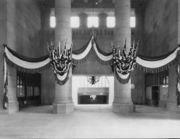
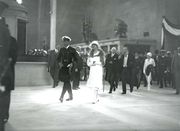
On July 13, 1906, the Toronto Terminals Railway (TTR) was incorporated by the Government of Canada to "construct, provide, maintain and operate at the City of Toronto a union passenger station." The TTR was jointly owned by the GTR and the CPR who each held 50% of the TTR shares. The TTR supervised construction of the new station which began in 1914 and proceeded to 1920, having faced significant delays in the shortage of construction material and workers as a result of the First World War, as well as the deteriorating financial position of the GTR due to its ill-fated transcontinental GTPR railway project.[6]
Although the headhouse and east and west office wings of the new station (the station building visible from Front Street West) were completed in 1920, it did not open to the public for another 7 years until the system of approach tracks were designed and implemented by the TTR and its owners. During this time in 1923, the bankrupt GTR was fully nationalized by the federal government and merged into the Canadian National Railways (CNR), which would assume the GTR's 50% ownership of the TTR and thus the third Union Station.
The station building's grand-opening and ribbon-cutting ceremony on August 6, 1927 was completed four days later when the track network was shifted over from the second Union Station on August 10. Demolition of the second Union Station began almost immediately and was completed in 1928. The third Union Station project was not fully completed until 1930 when the train shed was completed; its construction was supervised by the TTR from 1925-1930.[6]
The TTR owned and operated the network of trackage extending for approximately 5 km east and west of the station (3 statute miles) with over 25 statute miles of terminal trackage in this area. TTR provided all track maintenance and snow removal and controlled all of the interlocking which joined CNR's Oakville and Weston subdivisions in the west with CNR's Kingston and Bala subdivisions in the east as well as the CPR's Belleville subdivision in the east. Control of train movements was provided by the TTR's John Street, Cherry Street and Scott Street interlocking towers.
Central Heating Plant
The TTR also constructed a Central Heating Plant at the corner of York and Fleet streets (now Lakeshore Boulevard) to replace the original Toronto Hydro plant on Scott Street which had been expropriated by the TTR to build the approach track viaduct to the new station. It was fuelled by coal delivered by a CNR siding and was the largest such facility in Canada when it opened in 1929; it produced 150,000 kg/330,000 pounds of steam per hour and 270 million kg/600 million pounds annually to heat the station, the passenger cars in the train shed, CNR and CPR yard facilities in the area now occupied by the Gardiner Expressway, Rogers Centre and Air Canada Centre, as well as the CPR's Royal York Hotel, the Dominion Public Building, the federal post office building adjacent to the station and the CN/CP Telecommunications building on Front Street. The CHP was converted from coal to natural gas but was decommissioned in the 1980s and demolished in 1990.[6]
Subway connection
The first major change to Union Station took place in 1954 when the Toronto Transit Commission opened its Union subway station adjacent to Union Station but buried beneath Front Street West. This subway station acted as the southern terminus of its new subway line. The subway station included a direct tunnel connection to the lower level passenger concourse. This passageway was closed and replaced by the direct connection between the railway station and the subway station in 1979 when the subway station mezzanine was renovated and enlarged. In 1990, the TTC's Harbourfront LRT project added an underground streetcar loop currently used by the 509 Harbourfront and 510 Spadina streetcar lines. TTC passengers using the Union subway and streetcar station may transfer between both modes without entering the Union Station proper.
CityPlace redevelopment proposal
During the early 1970s, Canada's two major passenger railways, the Canadian Pacific Railway and Canadian National were reducing their services to the bare minimum mandated under the Canadian Transport Commission, largely as a result of unsustainable losses resulting from increased competition in new subsidized 4-lane highways and airports.
The third Union Station's future was looking bleak by 1972 when both railways sought to increase return on their underutilized waterfront rail classification yards which was being viewed as valuable real estate. Both CN and CP began to abandon their extensive waterfront rail classification yards south of the passenger station to make way for urban redevelopment. The Gardiner Expressway project was constructed over part of the railway property and CN had proposed constructing a telecommunication tower (what would become the CN Tower later that decade).
CN and CPR proposed a Metro Centre development on the south side of Front Street on the site of Union Station and proposed to demolish the structure (which was costing an increasing amount of property taxes but not bringing in revenue). The proposed Metro Centre development was strikingly similar to what occurred with New York City's Penn Station and would have consisted of an underground fourth Union Station (the terminal trackage would have been buried), a convention centre, a telecommunications tower, along with complementary office and retail developments. Local opposition to the proposal was successful in having the city council's decision to support the Metro Centre development overturned and Union Station was saved.
In 1978, CN and CP transferred responsibility for their passenger rail services to Via Rail, a new federal crown corporation, however both CN and CP retained their 50% ownership shares of the TTR.
Growth and waterfront development
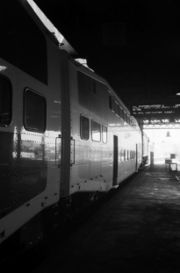
The GO Transit commuter rail agency which was established in 1967 had been undergoing unprecedented expansion which was seeing Union Station see passenger levels that outstripped some of the busiest airports in the world. The consolidated TTR trackage included a flyover west of the station to permit freight trains to cross CN's Oakville subdivision without blocking GO Transit's commuter trains. The flyover was constructed in 1982-83 and also allowed GO trains destined for the CN Weston subdivision to cross over the tracks used by GO and VIA trains using the CN Oakville subdivision.
The CN Tower had revamped the vision of Toronto's waterfront rail yards and proposals were made to construct what would later become the Skydome (1989) and the Air Canada Centre (1999), resulting in further changes to the Union Station trackage. The PATH pedestrian tunnel network was built to connect Union Station's passengers with many of the downtown office towers and a footbridge was constructed over the terminal trackage west of the station to connect the PATH with the Metro Toronto Convention Centre and the Skydome.
2000 sale
In 2000, the City of Toronto purchased the station building from the TTR, while GO Transit purchased the railway corridor and the Union Station train shed. The City of Toronto officially took over all management of the building itself on May 1, 2009; TTR continues to manage the train shed and track operations of the USRC under contract with GO Transit.
Shooting range
The CN Police and Canadian Pacific Railway Police Service used a shooting range in the building until the early 2000s when it was turned over to the Canadian National Recreation Association Gun Club. The range's lease was terminated effective August 29, 2008 after city council voted in support of the City Based Measures to Address Gun Violence.
2009 renovations
2009 Provincial and Federal budgets have included large sums of money to assist GO, Via and Toronto in developing and upgrading the station. Large sections of track has been upgraded with better signals and snow cleaning devices in the hope to reduce winter delays to train movement.
The train shed is being largely demolished and replaced with a glass ceiling.
Further upgrades include redesign of the lower floor levels in the east and west wings of the station building.
Current operations

The former Toronto Terminals Railway trackage is now known officially as the Union Station Rail Corridor (USRC) and the Railway is contracted by GO Transit to operate and maintain the train shed and USRC. TTR does not own property anymore; it has become a contracted management group who provides employees to maintain and operate the rail system on behalf of GO Transit.
Passenger services
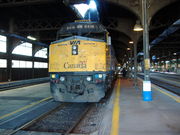
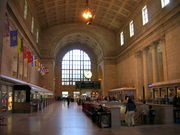

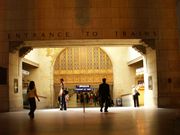
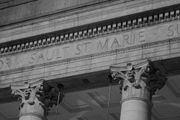
Union Station is the busiest public transportation structure in Canada, with more annual passengers than even the Toronto Pearson International Airport. It handles an average of 200,000 daily passengers or 65 million passengers annually.
Via Rail
- Canadian to Winnipeg, Saskatoon, Edmonton, and Vancouver
- Niagara Falls-Toronto to Oakville, Burlington, Hamilton and Niagara Falls
- Sarnia-Toronto to Brampton, Kitchener, Stratford, London and Sarnia
- Toronto-Ottawa to Oshawa, Belleville, Kingston, Brockville and Ottawa
- Toronto-Montreal to Oshawa, Belleville, Kingston, Brockville, Cornwall and Montreal
- Windsor-Toronto to Burlington, Brantford, Woodstock, London and Windsor
Amtrak
(intercity)
- Maple Leaf to Buffalo, Rochester, Syracuse, Albany and New York. Amtrak trains are staffed by VIA Rail staff while in Canada.
Ontario Northland
(intercity)
- Northlander to Gravenhurst, Huntsville, North Bay, Cobalt and Cochrane
GO Transit
(commuter rail)
- Barrie line to York University, Aurora, Newmarket and Barrie
- Georgetown line to Malton, Brampton and Georgetown
- Lakeshore East line to Scarborough, Guildwood, Pickering, Whitby and Oshawa
- Lakeshore West line to Mimico, Port Credit, Oakville, Burlington and Hamilton
- Milton line to Erindale, Streetsville, Lisgar and Milton
- Richmond Hill line to Langstaff and Richmond Hill
- Stouffville line to Agincourt, Markham and Stouffville
- Seasonal Weekend Service To Niagara Falls (Lasting August 22 to September 7, 2009) [7]
GO Transit's Union Station Bus Terminal is adjacent to the railway station.
Toronto Transit Commission subway
- Yonge-University-Spadina at Union subway station
Toronto Transit Commission streetcar
- 509 Harbourfront at Union streetcar station
- 510 Spadina at Union streetcar station
Toronto Transit Commission bus
Intercity bus
Intercity coaches stop across Front street from Union Station, in front of the York Street entrance to the Royal York Hotel or at the corner of University Avenue and Wellington Street, two blocks from Union Station.
- Inter-city bus to Guelph and Kitchener
- Inter-city bus to Hamilton, St. Catharines and Niagara Falls
- Inter-city bus to Peterborough
- Inter-city bus to Niagara Falls and Buffalo
- Inter-city bus to Buffalo and New York
Security
The City of Toronto has a security manager that oversees the station security guards on site, and the City is now fully in charge of managing the day to day operations of Union Station. Railway Police no longer patrol Union Station; they were replaced by security guards. GO Transit patrols its property including the Union Station Rail Corridor with a contingent of sworn Special Constables, who have the same authority as police officers while dealing with GO Transit matters. GO Transit also purchased the CN Don Yard, east of Union Station from CN and stores its train consists during the afternoon hours there.
Freight
Freight train movement is still active along the southern most track that by-passes the train shed and connects up with either the CN Oakville Sub, or the Kingston Sub. Typically freight movement is done during the off peak hours, so as to allow access to the hundreds of GO Transit and VIA Rail train movements during rush hour. The Union Station Rail Corridor is the busiest train corridor in Canada. If all the tracks were put end to end the Union Station Rail Corridor would stretch more than 80 km.
Future redevelopment plans
The lack of rail service to Toronto Pearson International Airport from the downtown has long been a thorn in the side of mass-transit planners in Toronto. Several competing proposals from the private sector (with government financing) were announced during the early 2000s, mostly requiring use of Union Station for a terminus. On November 13, 2003, Transport Canada announced the selection of Union Pearson AirLink Group to finance, design, construct, operate, and maintain a railway link between Union Station and the Toronto Pearson International Airport. It was planned that the line will use four refurbished Rail Diesel Cars, with trains running every fifteen minutes, seven days a week.
On July 24, 2003, the City of Toronto agreed to lease Union Station to SNC-Lavalin subsidiary Union Pearson AirLink Group for a term of 100 years. A public-private partnership was to be created to redevelop the station. The master plan for the Union Pearson Group development had four major components:
- An integrated public realm, redefining and joining the Union Plaza and Front Street spaces
- A modern station, including redevelopment of the train shed with construction above it
- Revitalization of underutilized spaces, notably redeveloped concourses, moats, and teamways
- Extended pedestrian connections, including improved passages, new entrances, and improved ease of movement
On April 26, 2006, the city's deal with the Union Pearson Group for the refurbishment of the station collapsed as the company was unable to meet a city imposed deadline.[8]
A subsequent announcement on May 24, 2006, addressed several issues for commuters including:
- Constructing a direct connection from the GO Concourse to the PATH pedestrian tunnel system
- A new eastbound platform for the Union TTC station
- Improved access to streetcars at Union TTC station
- Improved capacity for inter-city railway passengers
These developments were part of a $100 million initiative announced by the city and its transit authorities, along with the provincial and federal governments.[8]
Further details of the proposal indicate a complete overhaul of the concourse levels, deepening them to create two stories of space. The lower storey will provide retail space and room for pedestrian traffic flow, and the upper storey will be dedicated to passenger traffic onto the platforms. This will expand not only the current GO concourse in the east of the building, but also open up the western end; GO Transit's presence in the building will nearly quadruple. Additional aesthetic points include glass roofs over the moat space around the north sides of the building, and a tall atrium over the central portions of the platforms. A southern entrance adjacent to the Air Canada Centre will also be implemented. [1]
On August 5, 2009, the Toronto City Council approved an update of this plan which was projected to cost $640 million, with construction lasting from 2010 to 2014. The plan is once again a public-private partnership with Union Pearson AirLink Group.[9]
In late 2008 and early 2009 it was announced that GO Transit and the City of Toronto had been in secret talks that have allowed GO Transit to purchase and develop all the upper floors of Union Station. Those floors have thousands of square feet of office space that were once used by thousands of CN and CP Rail employees. Those floors and offices have been abandoned by the railways and currently only are occupied by a small number of VIA Rail, TTR and GO Transit employees. The plan is to eventually renovate the space and move GO Transit's Head Office to the area, currently located at 20 Bay Street. The purchase/lease would allow GO Transit to control vast areas of the Station, almost all the property except the Great Hall. GO Transit already leases space in the concourse level and the plan would also allow GO Transit and VIA to lease more space in the Great Hall area.
See also
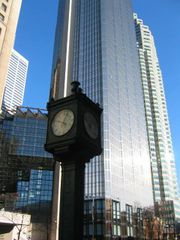
- A list of other railway stations (terminals or depots) in Toronto
- Toronto, Grey and Bruce Railway Terminal - south of Fort York
- Grand Trunk Freight House - Front and Simcoe
- Northern Railway Office - Spadina and Wellington
- Grand Trunk Passenger Terminal - Front and Yonge (now Sony Centre for the Performing Arts)
- Toronto and Nipissing Railway Passenger, Freight and Maintenance Terminal, Berkele Street - Front and Parliament
- Northern Railway Depot - south of St Lawrence Market
References
- ↑ 1.0 1.1 Globe & Mail (November 2007). "Underground mall in store for Union Station makeover.". http://www.theglobeandmail.com/servlet/story/LAC.20071124.UNION24/TPStory/TPNational/Ontario/. Retrieved 2007-11-24.
- ↑ 2.0 2.1 City of Toronto (March 2004). "Union Station by the numbers.". http://www.toronto.ca/union_station/numbers.htm. Retrieved 2007-11-24.
- ↑ Toronto Terminals Railway (November 2007). "Union Station design and architecture.". http://www.ttrly.com/design_architecture.htm. Retrieved 2007-11-24.
- ↑ Internet Movie Database listing of titles filmed at Union Station, Toronto, Ontario, Canada
- ↑ Filey, Mike (August 2007). "Union Station turns 80.". http://www.torontosun.com/Lifestyle/Columnists/Filey_Mike/2007/08/05/4395354-sun.html. Retrieved 2007-11-24.
- ↑ 6.0 6.1 6.2 Toronto Terminals Railway (November 2007). "Toronto Terminals Railway history.". http://www.ttrly.com/history.htm. Retrieved 2007-11-24.
- ↑ http://gotransit.com/public/en/destinations/niagarafalls.htm
- ↑ 8.0 8.1 Globe and Mail (April 2006). "City, private partner blame each other for collapse of Union Station deal.". http://www.theglobeandmail.com/servlet/story/LAC.20060429.UNION29/TPStory/TPNational. Retrieved 2007-11-24.
- ↑ "Toronto approves Union Station makeover" by Brodie Fenlon. Globe and Mail. 5 August 2009, p. A6.
Bibliography
- Toronto Union Station Master Plan
- CBC: Train station leased for 100 years
- Transport Canada Rail Link News Release
- Toronto's Union-Pearson Air-Rail Link
- Toronto Terminals Railway Company
- Underground exploration
External links
- VIA Rail - Toronto Union Station(English)
- ONR - Toronto Union Station(English)
|
||||||||||||||||||||||||||||||||||||||
|
|||||||||||||||||||||||||||||
|
||||||||||||||||||||||||||||||||